Columbia Pictures, being a poverty-row film studio for many years, was a little bit behind its rival studios throughout the 1930s and 1940s. They did not really make it into the big league until the mid-1930s when they began outputting some truly entertaining screwballs such as It Happened One Night ( 1934 ) and Frank Capra pictures like Mr. Smith Goes to Washington ( 1939 ). Technicolor was still a relatively new medium in the late 1930s, but studios like Metro-Goldwyn-Mayer, Warner Brothers and Paramount jumped on the color bandwagon, quickly hiring experts in the field of Technicolor to help them launch their upcoming blockbuster films like Gone With the Wind, The Adventures of Robin Hood, and The Wizard of Oz. Columbia Pictures didn't release their first Technicolor picture until 1943....but when they did they made it a doozy.
It was a western entitled The Desperadoes, and it featured one of the newest contract players at Columbia - Glenn Ford - as well as that charismatic warhorse of the westerns - Randolph Scott. Ford portrayed a wanted criminal who came out of hiding to do a bank job in a small western outpost, but instead falls in love with a local girl ( Evelyn Keyes ) and decides to reform.
A truly good western features colorful characters, plenty of adventure, a gentle romance, beautiful locales, and an interesting protagonist, and The Desperadoes featured all of this. Plus, it was packaged within a sprightly 87 minutes. Columbia really hit the bullseye with this film.
Randolph Scott, always a "good guy", was often cast in the part of a just sheriff in westerns before he became a leading player in the Budd Boetticher films of the 1950s. In The Desperadoes, his character is not unlike Sheriff Will Wright from Jesse James ( 1939 ). In both films, Scott portrayed a sheriff who was willing to pull off his tin star long enough to let a criminal he has faith in escape.....even though this same criminal heads off into the sunset with his gal! The gal, in this case, being Evelyn Keyes, a sweet-natured filly who works in her father's ( Edgar "Uncle Joe" Buchanan ) stable. Her faith in Glenn Ford makes him willing to risk his life exposing the real criminals who pulled the bank heist in town....one of whom happens to be Evelyn's father.
Also in the cast was Claire Trevor as a sympathetic saloon gal, Guinn "Big Boy" Williams as Ford's pal "Nitro", Raymond Walburn, Porter Hall and Joan Woodbury.
Friday, January 27, 2017
Tuesday, January 24, 2017
TV/Movie Set : Father Goose ( 1964 )
It is easy to praise the art directors who create visually stunning sets, those that are opulent ( Anastasia, The King and I, The Sound of Music ) or creative and modern ( Top Hat, Grand Hotel, The Thief of Bagdad ).....but the work put into designing a set that perfectly complements the film's story without being noticeable is just as, if not more, difficult to create.
Alexander Golitzen was a master at creating beautiful but unobtrusive sets. He designed hundreds of sets for westerns, comedies, mysteries, sci-fi classics, and melodramas from the 1940s-1960s, primarily at Universal Studios. We'll be covering this talented man's work in further detail in a future post, but for today we wanted to spotlight the sets in one of the films he worked on - the 1964 comedy Father Goose.
Golitzen was assigned to create two sets for this classic Cary Grant film : an island hut designed for use by a WWII plane spotter, and the interior of the command post where Trevor "Frank" Howard was stationed. Working with him on this project was Henry Bumstead, another veteran art director, who actually was still making films as late as 2006.
Father Goose was probably a very simple assignment for Golitzen and Bumstead, but they managed to design these two sets in such a way that the audience is unaware that there is only two sets. They blend in so well, and look so authentic, that it is easy to just assume that a location scout found these buildings on a deserted island and sent the cast and crew to film them.
First, let's take a look at Father Goose's island hut. Cary Grant portrays boozy bum "Walter" who has no interest whatsoever in taking part in the war effort.....that is, until Captain Frank Houghton ( Trevor Howard ) confiscates his boat and his liquor, holding them as ransom until Walter agrees to investigate the whereabouts of their missing spotter ( since Walter knows the islands like no other man in the Pacific ). Once there, he finds the spotter had died at the hands of the Japanese, and he asks to be picked up again by the Navy, but Houghton refuses, wanting Walter to take the place of the spotter instead, since he served such a vital job.
The hut he inherits from the former spotter is stashed with all the supplies you would imagine a spotter would be equipped with : radios, charts, a simple bunk, and loads of canned food. When my sister and I first saw Father Goose ( this was a good fifteen years ago ), it was the "decor" - if you'd call it that - of this hut that really caught our attention....and my imagination. I use to fantasize about being stranded on a Pacific island with just a little shack like that to live in.
John McCarthy Jr. and George Milo can take credit for the set decor. Each of these men had hundreds of television and film titles to their credits as well as numerous Oscar nominations. These set designers really did their homework to make Walter's temporary hut-home an authentic looking spotter's pad. To emphasize this:
After a recent re-watch of Father Goose several years ago, I decided I wanted to purchase a plane spotting chart just like Walter had in his hut. I searched eBay, WWII memorabilia forums, and even auction homes such as Sothebys...and I discovered something interesting: spotters were never issued plane spotting charts!
During the war, the government distributed enemy identification manuals to spotters, but never charts. McCarthy and Milo had cleverly created these solely for Father Goose to make the audience understand just what a plane spotter's work entails. Walter could have been shown hurriedly flipping through a manual to make an identification but the scene when he spots that Jap plane flying overhead and quickly darts into his hut scouring all of the charts plays out so much better with visual charts.
I wonder what became of those props......
Instead, as the old adage says - Necessity is the mother of Invention! I decided to make my own, duplicating the design that McCarthy and Milo had created for the film. A few days ago Diana and I launched a Kickstarter campaign - The Spotting Chart Project - in order to fund this endeavor, and lo and behold! there are other WWII plane spotting enthusiasts just like us.
We still have 15 days left on the campaign, so if you happen to fancy owning your very own Father Goose inspired plane spotting chart, please check it out ( or better yet, spread the word to your friends! ).
Click Here to Check out The Spotting Chart Project on Kickstarter!
To see more posts about TV/Movie Sets, click here!
Alexander Golitzen was a master at creating beautiful but unobtrusive sets. He designed hundreds of sets for westerns, comedies, mysteries, sci-fi classics, and melodramas from the 1940s-1960s, primarily at Universal Studios. We'll be covering this talented man's work in further detail in a future post, but for today we wanted to spotlight the sets in one of the films he worked on - the 1964 comedy Father Goose.
 |
| The Royal Australian Navy base headquarters |
Golitzen was assigned to create two sets for this classic Cary Grant film : an island hut designed for use by a WWII plane spotter, and the interior of the command post where Trevor "Frank" Howard was stationed. Working with him on this project was Henry Bumstead, another veteran art director, who actually was still making films as late as 2006.
Father Goose was probably a very simple assignment for Golitzen and Bumstead, but they managed to design these two sets in such a way that the audience is unaware that there is only two sets. They blend in so well, and look so authentic, that it is easy to just assume that a location scout found these buildings on a deserted island and sent the cast and crew to film them.
 |
| Walter wonders why booze is not among the RAN rations |
First, let's take a look at Father Goose's island hut. Cary Grant portrays boozy bum "Walter" who has no interest whatsoever in taking part in the war effort.....that is, until Captain Frank Houghton ( Trevor Howard ) confiscates his boat and his liquor, holding them as ransom until Walter agrees to investigate the whereabouts of their missing spotter ( since Walter knows the islands like no other man in the Pacific ). Once there, he finds the spotter had died at the hands of the Japanese, and he asks to be picked up again by the Navy, but Houghton refuses, wanting Walter to take the place of the spotter instead, since he served such a vital job.
 |
| Catherine considers Walter's eating habits "revolting"....but at least his bed has no bugs |
The hut he inherits from the former spotter is stashed with all the supplies you would imagine a spotter would be equipped with : radios, charts, a simple bunk, and loads of canned food. When my sister and I first saw Father Goose ( this was a good fifteen years ago ), it was the "decor" - if you'd call it that - of this hut that really caught our attention....and my imagination. I use to fantasize about being stranded on a Pacific island with just a little shack like that to live in.
 |
| In a rainstorm, Walter's hut lets in a little water.... |
John McCarthy Jr. and George Milo can take credit for the set decor. Each of these men had hundreds of television and film titles to their credits as well as numerous Oscar nominations. These set designers really did their homework to make Walter's temporary hut-home an authentic looking spotter's pad. To emphasize this:
After a recent re-watch of Father Goose several years ago, I decided I wanted to purchase a plane spotting chart just like Walter had in his hut. I searched eBay, WWII memorabilia forums, and even auction homes such as Sothebys...and I discovered something interesting: spotters were never issued plane spotting charts!
 |
| Was that a Type 99 dive bomber, or a Type 0 fighter? |
During the war, the government distributed enemy identification manuals to spotters, but never charts. McCarthy and Milo had cleverly created these solely for Father Goose to make the audience understand just what a plane spotter's work entails. Walter could have been shown hurriedly flipping through a manual to make an identification but the scene when he spots that Jap plane flying overhead and quickly darts into his hut scouring all of the charts plays out so much better with visual charts.
I wonder what became of those props......
Instead, as the old adage says - Necessity is the mother of Invention! I decided to make my own, duplicating the design that McCarthy and Milo had created for the film. A few days ago Diana and I launched a Kickstarter campaign - The Spotting Chart Project - in order to fund this endeavor, and lo and behold! there are other WWII plane spotting enthusiasts just like us.
 |
| A sample of our newly created Father Goose inspired spotting charts! |
Click Here to Check out The Spotting Chart Project on Kickstarter!
To see more posts about TV/Movie Sets, click here!
Friday, January 20, 2017
The Impossibly Difficult Name that Movie Game
Ahhh.....c'est amour! They make a handsome couple don't they? And the background locale couldn't be more moodily picturesque. Now, we'll leave you to enjoy this scene and ponder just who these two lovebirds are and from what film this screenshot was taken from. But since this is a difficult one we'll throw in a hint : it is not from a silent film.
As always, if you are not familiar with the rules to the Impossibly Difficult Name that Movie game or the prize, click here!
GAME OVER.
Congratulations to "Aunt Sandra" for correctly guessing ( via email ) "Vanessa: Her Love Story" ( 1935 ). Those lovebirds are none other than Robert Montgomery and Helen Hayes, smooching with the bonny Highlands behind them.
Sunday, January 15, 2017
Nikki, Wild Dog of the North ( 1961 )
During the 1950s and 1960s, Walt Disney Studios produced a number of excellent documentary-story films centered around wildlife, the majority of them being released under James Algar's True-Life Adventure series banner. One film, however, was released as a feature film independently....Nikki, Wild Dog of the North ( 1961 ). While it bore a remarkable resemblance to the True-Life Adventure series, the film was not produced by Algar and was helmed by two different directors - Don Haldane and cinematographer Jack Couffer.
Based upon James Oliver Curwood's "Nomads of the North" the film tells the story of Nikki, a wolf dog, and the adventures he encounters in the wild north woods of Canada. Nikki is trapper Andre Dupas' ( Jean Coutu ) beloved hunting dog, but when they get separated in the water rapids, Nikki learns to fend for himself while he waits for his master's return.
Nikki is a highly entertaining blend of true-life documentary sequences ( complete with narration by Jacques Fauteux ) and dialogue scenes with actors. Just like Disney's True-Life Adventure series, the film features impressive scenery and spectacular wildlife footage. Some particularly startling shots are the grizzly bear and black bear fight, the scene of Nikki and Neewa forging the rapids, and Nikki luring a muskrat out of its underground home in the middle of an iced lake.
Nikki is not the best film to watch with children, however. Since this is true-to-life, the dog encounters a number of hardships throughout his journey. The bear attacks will send a few goosebumps down your back, Nikki gets himself bloodied up when his paw gets caught in a wolf trap, and there is a brutal fight between Dupas and LeBeau ( Emile Genest ) who was cruelly training Nikki to become a fighter-dog. Genest would later appear in Disney's Big Red ( 1962 ) playing a kindly animal trainer, but here he is a hissable villain.
Critics and audiences warmed to Nikki upon its initial release but over the years it has become obscure - even among Disney audiences. Fortunately, the film has since been beautiful remastered and is now available for viewing on Hoopla and on DVD.
Based upon James Oliver Curwood's "Nomads of the North" the film tells the story of Nikki, a wolf dog, and the adventures he encounters in the wild north woods of Canada. Nikki is trapper Andre Dupas' ( Jean Coutu ) beloved hunting dog, but when they get separated in the water rapids, Nikki learns to fend for himself while he waits for his master's return.
Nikki is a highly entertaining blend of true-life documentary sequences ( complete with narration by Jacques Fauteux ) and dialogue scenes with actors. Just like Disney's True-Life Adventure series, the film features impressive scenery and spectacular wildlife footage. Some particularly startling shots are the grizzly bear and black bear fight, the scene of Nikki and Neewa forging the rapids, and Nikki luring a muskrat out of its underground home in the middle of an iced lake.
Nikki is not the best film to watch with children, however. Since this is true-to-life, the dog encounters a number of hardships throughout his journey. The bear attacks will send a few goosebumps down your back, Nikki gets himself bloodied up when his paw gets caught in a wolf trap, and there is a brutal fight between Dupas and LeBeau ( Emile Genest ) who was cruelly training Nikki to become a fighter-dog. Genest would later appear in Disney's Big Red ( 1962 ) playing a kindly animal trainer, but here he is a hissable villain.
Critics and audiences warmed to Nikki upon its initial release but over the years it has become obscure - even among Disney audiences. Fortunately, the film has since been beautiful remastered and is now available for viewing on Hoopla and on DVD.
Wednesday, January 11, 2017
From the Archives : Diana Lewis Goes West
Diana Lewis donned the cowgirl outfit for her role in the Marx Brother's comedy Go West ( 1940 ) released by Metro-Goldwyn-Mayer. This was Ms. Lewis' first western role, and judging from her mood when this behind-the-scenes photograph was taken, she seems to be enjoying the thrill of the western setting.
From the Archives is our latest series of posts where we share photos from the Silverbanks Pictures collection. Some of these may have been sold in the past, and others may still be available for purchase at our eBay store : http://stores.ebay.com/Silverbanks-Pictures
From the Archives is our latest series of posts where we share photos from the Silverbanks Pictures collection. Some of these may have been sold in the past, and others may still be available for purchase at our eBay store : http://stores.ebay.com/Silverbanks-Pictures
Saturday, January 7, 2017
Carroll Clark and Emile Kuri - Setting the Scene for Walt Disney
This edition of our Behind the Screen - The Hidden Masters of the Golden Age of Filmmaking series was going to be a feature on one of my favorite art directors - Carroll Clark. But it is very difficult to praise the work of an art director without giving due praise to the set decorator who, through the use of furnishings, props and small personal objects make the sets “come alive”. And so, this post will pay tribute to Carroll Clark and Emile Kuri…the art director and set decorator or just about every live-action Walt Disney film made between 1955-1972. Wow, is that a lot of movies! Due to the limited amount of space on this blog... I’ll just be highlighting these Disney films and will cover more detail about Clark's work in the 1940s in a future post.
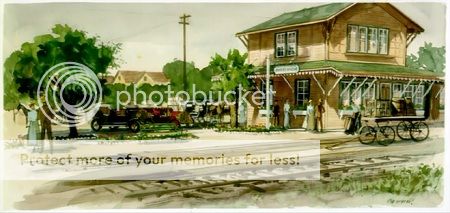 Carroll Clark was born in Mountain View, California on February 6, 1894. He got his formal training in architecture but decided to pursue commercial design instead, which eventually led to his getting a position as art director for Pathe studios during the mid-1920s.
Carroll Clark was born in Mountain View, California on February 6, 1894. He got his formal training in architecture but decided to pursue commercial design instead, which eventually led to his getting a position as art director for Pathe studios during the mid-1920s.
In 1930 Howard Hughes selected him to be art director on his high-flying war adventure Hell’s Angels and Clark began to get more assignments his way. However, it was when he joined RKO studios two years later that he accomplished his real triumphs of design ingenuity.
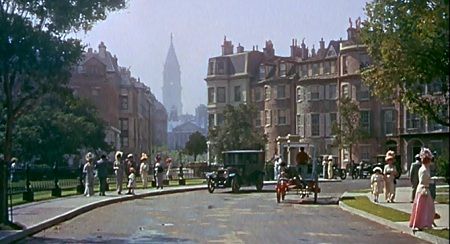 Now is a good time to introduce Emile Kuri, for around this year he was beginning to make his mark in Hollywood too. Emile Kuri was born in Mexico on June 14, 1907 to Lebanese parents. When Emile was only 12 years old, his father died, and needing to support his mother and siblings he found work at a furniture store in Hollywood. One day during lunch hour, while all the salespeople were away, a wealthy woman came into the store looking for articles to decorate a room in her house and Emile gladly made suggestions…even though his job was just to dust the furniture. She liked his taste and suggestions so much she asked if he could re-decorate her and her husband’s house. Her husband was Hal Roach.
Now is a good time to introduce Emile Kuri, for around this year he was beginning to make his mark in Hollywood too. Emile Kuri was born in Mexico on June 14, 1907 to Lebanese parents. When Emile was only 12 years old, his father died, and needing to support his mother and siblings he found work at a furniture store in Hollywood. One day during lunch hour, while all the salespeople were away, a wealthy woman came into the store looking for articles to decorate a room in her house and Emile gladly made suggestions…even though his job was just to dust the furniture. She liked his taste and suggestions so much she asked if he could re-decorate her and her husband’s house. Her husband was Hal Roach.
Emile impressed Mr. Roach with his innate flair for decorating and soon found himself working as the set decorator on Roach’s comedy classic Topper ( 1938 ). His career as a set decorator had begun – and what an impression on film design he would make!
Throughout his career with Warner Brothers and Paramount studios during the 1940s and 50s he worked with such directors as William Wyler ( The Heiress ), Frank Capra ( It’s a Wonderful Life’s Bedford Falls was Emile’s creation ) George Stevens ( A Place in the Sun, Shane ) and Alfred Hitchcock ( Spellbound, Rope, Trouble with Harry ).
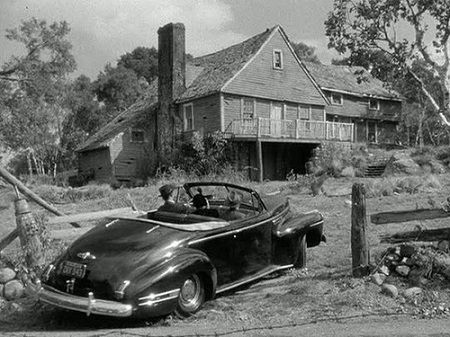 Carroll Clark was also working with Hitchcock during the 1940s ( Suspicion, Notorious ) and was busy creating beautiful sets for such classics as I Remember Mama ( 1948 ), The Bachelor and the Bobby-Soxer ( 1947 ), and Mr. Blandings Buildings His Dream House ( 1948 ).
Carroll Clark was also working with Hitchcock during the 1940s ( Suspicion, Notorious ) and was busy creating beautiful sets for such classics as I Remember Mama ( 1948 ), The Bachelor and the Bobby-Soxer ( 1947 ), and Mr. Blandings Buildings His Dream House ( 1948 ).
In 1953, Walt Disney hired Emile Kuri to give Walt Disney Studios’ office complex a face-lift. Plans for 20,000 Leagues Under the Sea were under way and once again Emile was in the right place at the right time. He became set decorator for the film, and his creative use of ironwork, velour, and ship parts earned him his second Academy Award and helped inspire a new Jules Verne Victorian fantasy style – Steampunk.
 Carroll Clark arrived at Disney Studios not long after for his first assignment, Darby O’Gill and the Little People ( 1959 ) and thereafter the talented designing duo were working side by side for the next 15 years.
Carroll Clark arrived at Disney Studios not long after for his first assignment, Darby O’Gill and the Little People ( 1959 ) and thereafter the talented designing duo were working side by side for the next 15 years.
The sets and décor for Toby Tyler ( 1959 ), The Absent Minded Professor ( 1959 ), Pollyanna ( 1960 ), Babes in Toyland ( 1960 ), The Parent Trap ( 1961 ), Summer Magic ( 1963 ), Mary Poppins ( 1964 ), and That Darn Cat ( 1965 )were all their handiwork.
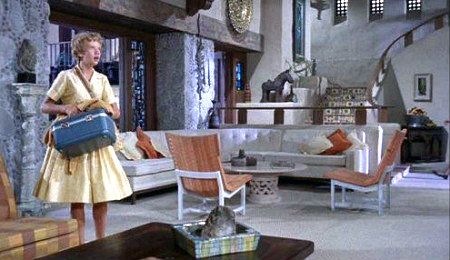 While an art director has the task of setting the scene, it is in the set decorator’s hands to furnish that setting with objects in keeping with the art director’s vision. "The most difficult thing," Kuri once told an interviewer, "is to make a set not look like a set, but like a home, as if the people just walked out."
While an art director has the task of setting the scene, it is in the set decorator’s hands to furnish that setting with objects in keeping with the art director’s vision. "The most difficult thing," Kuri once told an interviewer, "is to make a set not look like a set, but like a home, as if the people just walked out."
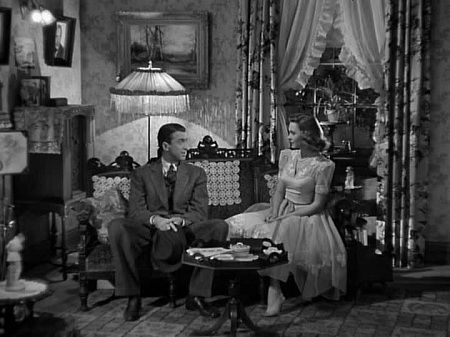 Emile Kuri knew how to convey character through the use of objects in a set. This is especially evident in A Place in the Sun, It’s A Wonderful Life, and in Pollyanna and Mary Poppins. The Banks household at 17 Cherry Tree Lane is very old "banker"ish and yet quite modern... and quite feminine... just overall a happy place to live in.
Emile Kuri knew how to convey character through the use of objects in a set. This is especially evident in A Place in the Sun, It’s A Wonderful Life, and in Pollyanna and Mary Poppins. The Banks household at 17 Cherry Tree Lane is very old "banker"ish and yet quite modern... and quite feminine... just overall a happy place to live in.
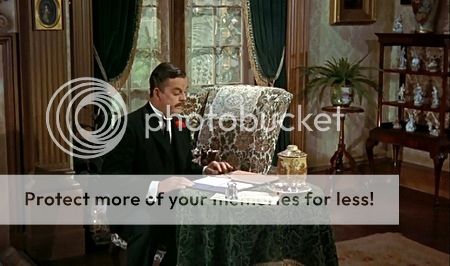
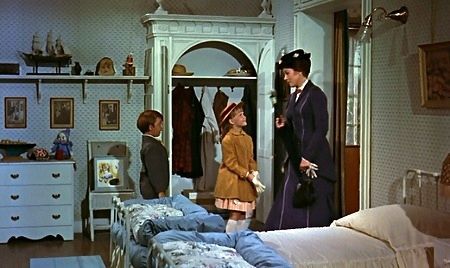
But let’s not forget that the look of Cherry Tree Lane itself came from the mind of the art director, Carroll Clark, too.
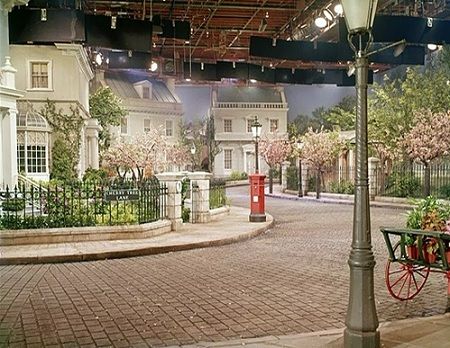 In The Happiest Millionaire and Pollyanna, Emile Kuri made great use of light toned furniture and abundant greenery to add color and cheerfulness to the Victorian residences of two wealthy upper-class families.
In The Happiest Millionaire and Pollyanna, Emile Kuri made great use of light toned furniture and abundant greenery to add color and cheerfulness to the Victorian residences of two wealthy upper-class families.
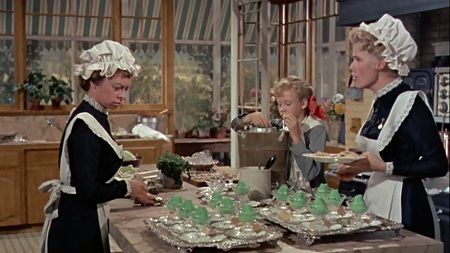
During the mid 1960s the team worked on such classic live-action films as The Ugly Dachshund, The Monkey’s Uncle, Adventures of Bullwhip Griffin, Blackbeard’s Ghost, The Horse in the Grey Flannel Suit and The Love Bug.
The Love Bug was Carroll Clark’s final feature. He passed away on May 17th, 1968, after designing the sets to over 172 feature films in his career.
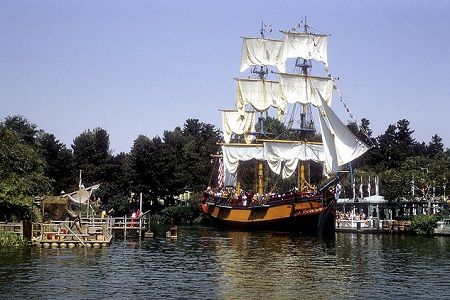 Emile Kuri continued to work at Walt Disney Studios up until his retirement in 1973. In addition to using his skill of set decorating for film, Emile Kuri worked on the sets of Disneyland as well, designing the interior to the Columbia sailing ship and the New Orleans Plaza Inn.
Emile Kuri continued to work at Walt Disney Studios up until his retirement in 1973. In addition to using his skill of set decorating for film, Emile Kuri worked on the sets of Disneyland as well, designing the interior to the Columbia sailing ship and the New Orleans Plaza Inn.
 Emile Kuri earned 8 Academy Awards nominations in his lifetime, but more importantly than the awards and accolades he received was the wonderful interiors that he created for all those Walt Disney films that have become so memorable and identifiable with the film itself and the characters. Of all the films that Emile Kuri and Carroll Clark worked on, I love The Parent Trap set the best...and so, I'll close here with a screenshot from that magnificent modern kitchen.
Emile Kuri earned 8 Academy Awards nominations in his lifetime, but more importantly than the awards and accolades he received was the wonderful interiors that he created for all those Walt Disney films that have become so memorable and identifiable with the film itself and the characters. Of all the films that Emile Kuri and Carroll Clark worked on, I love The Parent Trap set the best...and so, I'll close here with a screenshot from that magnificent modern kitchen.

In 1930 Howard Hughes selected him to be art director on his high-flying war adventure Hell’s Angels and Clark began to get more assignments his way. However, it was when he joined RKO studios two years later that he accomplished his real triumphs of design ingenuity.
Van Nest Polglase, one of the most influential production designers of the American cinema, was working on sets for Merium C. Cooper’s epic thriller King Kong ( 1933 ) and hired Carroll Clark as an assistant on the project. The two worked well together and soon after were sharing credit ( and Academy Award nods ) for creating the imaginative and elegant art deco sets for the Fred Astaire/Ginger Rogers films Flying Down to Rio, Roberta, Top Hat, and later Carefree.
Carroll Clark was kept busy throughout the 1930s and early 1940s, on films such as The Little Minister, Enchanted April, Hitler’s Children, Murder my Sweet, and The Enchanted Cottage. Clark made the "enchanted" cottage simple and cozy and inviting through his open-floor plan, and use of wide beams, diamond-paned windows, and stonework.
Carroll Clark was kept busy throughout the 1930s and early 1940s, on films such as The Little Minister, Enchanted April, Hitler’s Children, Murder my Sweet, and The Enchanted Cottage. Clark made the "enchanted" cottage simple and cozy and inviting through his open-floor plan, and use of wide beams, diamond-paned windows, and stonework.

Emile impressed Mr. Roach with his innate flair for decorating and soon found himself working as the set decorator on Roach’s comedy classic Topper ( 1938 ). His career as a set decorator had begun – and what an impression on film design he would make!
Throughout his career with Warner Brothers and Paramount studios during the 1940s and 50s he worked with such directors as William Wyler ( The Heiress ), Frank Capra ( It’s a Wonderful Life’s Bedford Falls was Emile’s creation ) George Stevens ( A Place in the Sun, Shane ) and Alfred Hitchcock ( Spellbound, Rope, Trouble with Harry ).

In 1953, Walt Disney hired Emile Kuri to give Walt Disney Studios’ office complex a face-lift. Plans for 20,000 Leagues Under the Sea were under way and once again Emile was in the right place at the right time. He became set decorator for the film, and his creative use of ironwork, velour, and ship parts earned him his second Academy Award and helped inspire a new Jules Verne Victorian fantasy style – Steampunk.

The sets and décor for Toby Tyler ( 1959 ), The Absent Minded Professor ( 1959 ), Pollyanna ( 1960 ), Babes in Toyland ( 1960 ), The Parent Trap ( 1961 ), Summer Magic ( 1963 ), Mary Poppins ( 1964 ), and That Darn Cat ( 1965 )were all their handiwork.




But let’s not forget that the look of Cherry Tree Lane itself came from the mind of the art director, Carroll Clark, too.


During the mid 1960s the team worked on such classic live-action films as The Ugly Dachshund, The Monkey’s Uncle, Adventures of Bullwhip Griffin, Blackbeard’s Ghost, The Horse in the Grey Flannel Suit and The Love Bug.
The Love Bug was Carroll Clark’s final feature. He passed away on May 17th, 1968, after designing the sets to over 172 feature films in his career.


Subscribe to:
Comments (Atom)












